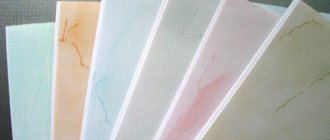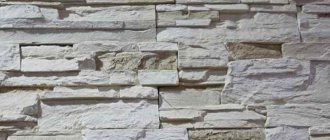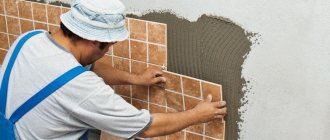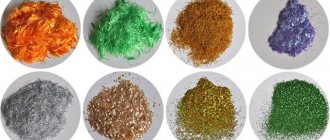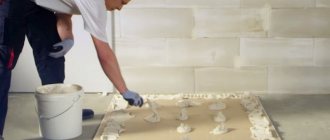A wonderful thing is plasterboard, convenient, technologically advanced, and now indispensable when decorating premises. But for now, many people attach gypsum boards the old fashioned way - to the profile, although this is not the only way to fix it in the right place. We are talking about gluing sheets. The quality of fastening may be in no way inferior to that made using a metal frame, but for this you need to follow the technology and choose the right adhesive for drywall.
Advantages of the glue method:
- ease of installation;
- gaining time;
- saving money, which costs the purchase and installation of the frame;
- increase in space - lathing would take 5-6 cm of space from each wall.
When are gypsum board adhesives used?
Cases when it is better to attach plasterboard sheets to surfaces using the adhesive method:
- When leveling main walls with differences, blockages and other irregularities up to 50 mm. However, with large potholes, the cost of too much glue can exceed the cost of a metal frame and make the idea uneconomical.
- When leveling the ceiling. But in this case, while the glue is setting, the gypsum board must be securely fixed so that it does not collapse under its own weight. Dowel-screws will solve the problem.
- When designing door and window slopes.
Creating a door slope from gypsum plasterboard
Forming a slope by gluing drywall
Glue can be used when fixing the second layer of drywall with a 2-layer sheathing of a frame or sheathing, but this is rarely practiced: using self-tapping screws in this case is faster and cheaper.
Comparison of glue and frame methods
As you already understand, there are two types of installation of drywall on walls:
- using a metal frame (sometimes a wooden one is used);
- frameless method - gluing.
Each of them has a number of advantages and disadvantages.
The advantages of the frame method definitely include:
- reliability;
- high quality construction.
The disadvantages of the frame method are as follows:
- high cost due to the use of profiles;
- complexity of installation;
- this method, as already mentioned, steals the useful space of the room.
The advantages of fixing drywall with glue are:
- installation directly on the wall;
- less labor-intensive installation process;
- can be installed in places of high humidity;
- does not reduce the usable area of the room.
There are few disadvantages, but they exist:
- the wall must first be leveled;
- The adhesive layer may deteriorate due to dampness.
So, you've decided to glue the drywall to the wall rather than mount it to the frame. To do this, you will need to explore several methods. The laying of sheets depends on the surfaces on which the drywall is glued.
Drywall adhesive: which one to choose?
The list of types of adhesives recommended for attaching drywall is quite extensive:
- Specialized glue (“Perlfix” from the German one, “Ceresit”, Russian analogues “Volma” and “Montazh”).
- Plaster or putty based on gypsum. In terms of price, quality of adhesion to the surface being glued, and the degree of shrinkage during setting, there is practically no significant difference with specialized adhesives for working with plasterboard.
- Acrylic putty. Used when subsequent tiling is planned. The composition protects walls from mold, the harmful effects of fungi and high humidity. With it, drywall is attached to a base made of wood, shell rock, stone and foam blocks.
- Polyurethane assembly adhesive in an aerosol can. An ideal material for installing gypsum boards and gluing seams on curved walls. With its help you can level the ceiling and attach ceramic tiles. To work with it, you need a special gun that ensures economical consumption of the solution.
- Polyurethane foam with a low coefficient of expansion replaces glue.
- Tile adhesive. Its mobility and fine-grained filler make work convenient and fast.
- Sealant. Any type of sealant replaces glue intended for gypsum plasterboards; in addition, it allows you to process joints, corners, and close cracks, making them impervious to moisture.
USEFUL INFORMATION: GKL "Gyproc": types and characteristics of material
- Liquid Nails. A strong adhesive that is safe for health, but requires time to dry and is designed for a load of up to 15 kg. It is quite suitable for gluing not the thickest drywall.
Note! The mixture for attaching gypsum boards from Knauf requires professional skills; work must be carried out without delays, since the glue hardens quickly.
Materials for gluing drywall
Currently, it is recommended to buy the following types of adhesive mixtures :
- Specialized glue Knauf perlfix;
- Gypsum-based adhesive mixtures such as Belgips, produced by Volma;
- Elastic polyurethane compositions such as Polymin;
- Silicone sealants, such as Bolars;
- Fugenfüller putty (10% building gypsum can be added to reduce setting time).
Knauf perlfix
Perlfix mixture is used for attaching gypsum boards to any type of base. The composition has maximum moisture resistance and can be used for installing drywall in the bathroom, on the balcony, loggia or in the kitchen. To increase the reliability of adhesion, synthetic fiber fiber can be added to it when preparing the composition. The mixture is quite economical and has low consumption. However, its drying time is quite significant - from 5 days to a week.
The most popular composition for fastening gypsum boards
Gypsum glue
It is one of the most flexible compositions. Its use is allowed if the bases have minor defects and irregularities up to 20 mm. The material is resistant to biological influences (mold, mildew, rot) and can be used in rooms with high humidity. The main technological feature is that the material does not shrink after drying. Can be used for fastening polystyrene foam, polyurethane foam and other polymer thermal insulation materials.
Applying gypsum glue
Polyurethane compounds
Sold in cylinders in the form of ready-to-use mixtures. The composition is squeezed onto the surface of the plasterboard with a special gun, which ensures economical consumption of material. To form a denser consistency, fragmented polystyrene foam is added to some compositions. Polyurethane foam adhesive is used to attach sheets to bases with a minimum number of defects. Gives quick drying and reliable fastening. Can be used for installation of ceramic tiles.
Application of polyurethane adhesive mixture
Silicone sealant
Used for attaching small segments of drywall to surfaces that have minimal adhesion: dense reinforced concrete, metal, wood, plastic. The adhesive provides reliable adhesion and is completely resistant to moisture and biological damage. Can be used for gluing piece decorative materials that are light in weight to the gypsum board surface.
Silicone sealant for attaching small segments of plasterboard
Fugenfüller putty
The Knauf fugenfüller mixture is not the most reliable specialized adhesive for attaching gypsum boards. But its use is quite acceptable for foundations with significant unevenness. Weakly affected by moisture.
The base can be natural or artificial stone, foam concrete blocks, shell rock, wood, etc. To increase the setting speed, it is allowed to add 1/10 building gypsum to the putty.
How to glue drywall to brick, gas and foam concrete
For uneven surfaces with wide joints, such as brick, foam and aerated concrete, it is convenient to glue plasterboard sheets with gypsum glue or any other gypsum mixture. In addition to the high-quality result, the advantage is cost-effectiveness: usually 5 kg of Perlfix is consumed per 1 m², the price of which is 300 rubles. for a 30 kg bag.
Inexpensive polyurethane foam is comparable in cost to gypsum glue. A 750 mm cylinder for spot application is enough for 8–10 m², the cost per square is 30–40 rubles. However, here, if there is a large gap between the gypsum board and the wall, solving the problem of foam expansion, each sheet will have to be additionally attached with dowel screws.
Preparing the base
Before gluing the drywall directly, the surface is primed and grooves are made for electrical wiring. When masonry, serious attention is paid to eliminating inherent cracks and irregularities. For this purpose, leveling putty mixtures are used. In some cases, to eliminate defects, you can glue strips of plasterboard and mounting tape.
Foam and gas blocks usually do not create similar problems, but damage can occur due to careless transportation and unloading. They are eliminated with a gypsum mixture.
What adhesive compositions are required for concrete floors
Typically, monolithic walls do not have obvious irregularities; gluing gypsum plasterboard onto them is hassle-free and quick. For this purpose you can choose:
- gypsum adhesive for plasterboard sheets;
- plaster putty;
- acrylic putties;
- cement adhesive for gluing tiles;
- polyurethane glue;
- polyurethane foam.
Each product with a minimum adhesive joint will ensure a strong connection between drywall and concrete.
“Betonokontakt”, a primer that contains acrylic polymers, cement, and quartz filler, has impeccable technical characteristics. Its feature is special additives and additives that guarantee reliable contact with the most difficult and dusty surface, which is usually the case with concrete.
When the base is polystyrene foam, polystyrene foam
Polystyrene foam and expanded polystyrene protect the home from the cold, but to prevent destruction and prepare the walls for finishing they require covering them with plasterboard. As a rule, covering a room with foam plastic steals 5 or even 10% of the usable area. If, in addition, you place drywall on a metal profile, the loss of space will be even greater, so gypsum board stickers are the best option here. The following will successfully complete the task:
- adhesive foam for drywall;
- acrylic putty.
USEFUL INFORMATION: Drywall cutter: types of knives and their features
GKL and gypsum fiber
Sometimes it becomes necessary to glue plasterboard onto a similar plasterboard or gypsum fiber sheet. There are no irregularities on such bases, so any adhesives that provide a minimum seam size are suitable for the job. It can be:
- acrylic putty;
- liquid Nails;
- silicone sealant.
Suitable materials are foam, gypsum and cement adhesives, but the thickness of the joints when using them will be greater and will cause an irrational reduction in the space of the room.
Option No. 1 (for smooth walls)
It is used on walls without differences (usually concrete or plastered surfaces).
- The walls are grooved, the cable is secured in the resulting grooves, and holes are made for sockets and switches.
- A primer is applied to the dust-free surface. If the wall is painted and the adhesive composition does not stick, a composition with quartz filler solves the problem.
- Holes for electrical equipment are cut out in the plasterboard.
The adhesive composition needs to be prepared for 1-2 sheets, especially at first, when there is no necessary skill.
- Gypsum-based glue is applied to the plasterboard with a notched trowel, and the excess is removed. If a different composition is used, for example polyurethane glue, it can be applied in stripes or as shown in the photo.
- The sheet is placed face down next to the installation site.
- Before sticking, carefully lift it and guide the wires into the prepared holes.
- The sheet is applied effortlessly to the wall, using the rule, they find places where the material should be attached more tightly to the surface, this is achieved by tapping the sheet with your hand or applying a board and lightly hitting it with a mallet. You should not knock on the level - this is a precision tool that will fail before the floors become level.
Materials and tools
To carry out work on installing gypsum board sheets on top of each other, special adhesive compositions are used. One of the popular materials for installation is “PENOSIL Premium Fix&Go Montage”. The glue consumption is small. One cylinder is enough for 10-15 m2. Since the glue is intended for professional use, you will need a gun to apply it.
According to the technology for gluing plasterboard sheets, it is necessary to seal the joints on the first layer of material. For this you will need serpyanka and gypsum putty. There is a large selection of gypsum dry mixes on sale; you can use KNAUF Polymer Finish or KNAUF Fugen compositions. The putty is applied using two spatulas.
And the last thing that is required for the work is a primer, because before gluing a sheet of drywall, the base on which it is planned to be attached must be thoroughly primed. The primer used is acrylic, deep penetration. Apply with a roller or wide brush.
You will also need auxiliary tools:
- Knife for cutting drywall sheets
- Tape measure, construction pencil or marker for marking
- Drywall saw if you need to make a curved cut
- Dry and clean cloth to remove excess glue
- Level for plane control
- Drill with whisk for preparing putty solution
Option No. 2 (irregularities up to 2 cm)
When the difference in wall level approaches 2 cm, the drywall should be glued in a different way, although the preparation of the surface and plasterboard, primer, and laying of the electrical cable do not differ from the previous option.
Instructions for gluing gypsum boards to moderately uneven walls are as follows:
- Prepare the adhesive mixture in larger quantities than in the first case, apply it to the drywall not with a notched trowel, but in separate dots or even piles, as in the next photo - this way the unevenness will be leveled out and, as a result, a strong fixation of the plasterboard on the wall will be ensured.
USEFUL INFORMATION: Step-by-step instructions for drywall work: making your own ceiling and walls
- The sheet is placed on pads at the fastening point - the beginning, as a rule, is the most protruding section of the wall surface.
Glue dots are made along the perimeter of the sheet at a distance of 25 cm from each other, inside the perimeter they are placed every 40 cm. There should not be large gaps so that the reliability of the fastening does not suffer. For the same reason, you need to ensure that the height of the points is greater than the differences in wall level.
- Gluing begins by bringing the electrical wires out and lightly pressing the drywall, which should simply cling to the wall. It is better to work together, so that one master constantly holds and, if necessary, helps press the sheet.
- The final fastening is preceded by a thorough check of the plane in all directions to determine in which places to press the material. When flaws are identified, individual sections are tamped down, and the process continues until complete satisfaction with the result.
A special option when drywall is attached to a surface made of gas or foam concrete. In this case, for reliable fixation, the adhesive composition is applied not to the sheet, but to the wall, although this method requires care - when installing the gypsum board, it can be easily warped.
Installation on walls with minor irregularities
How to glue drywall to a wall that has uneven surfaces? In essence, you do everything the same, but you will need a different glue and a thicker layer. Preparation consists of points already known to you:
- gating the wall for wiring;
- drilling for sockets or switches;
- surface primer.
To glue drywall, you will need to apply glue in parts (piles). Use a trowel or narrow spatula. Lay out piles along the entire perimeter, keeping a distance of 20–25 cm between them. In the middle, lay out two more rows, the distance between which is 40–50 cm, and between the piles in them — 30–35 cm.
It is important to know! The thickness of the pressed layer of glue should be 5–30 mm.
Now place the sheet on the pads, level it with the rule. When everything is ready, it's time to glue the drywall. Place it against the wall, check with a level, and then apply a rule and tap to level it.
??
You can apply the adhesive solution directly to the walls. How to glue drywall on uneven surfaces is up to you. But practice shows that it is better to apply heaps of glue on the sheet itself.
Option No. 3 (differences more than 2 cm)
Technology for surfaces with large unevenness:
- Remove weak areas of plaster from the ceiling.
- The walls are carefully primed.
- Beacons are prepared: 100 mm wide strips are cut out of plasterboard, necessary to create a level base. These elements are placed along the perimeter of the wall and vertically every 40–60 cm. They are fixed using glue, the layer of which is adjusted taking into account level differences.
- The main sheets of drywall are glued to the beacons after the glue on the strips has completely hardened. They are attached using the composition that was used to create lighthouses. The adhesive mass is applied in lines along the width of the guides, after which the sheet is lifted and pressed against the beacons. If they are aligned correctly, installation will not be difficult.
- The joints of the canvases are treated with glue or special putty.
- After drying, prime again, allow time to dry, and finally putty the surface of the drywall.
The gypsum board sticker, like any other task, is feasible for those who love and know how to work. Such people will benefit from today's publication. For those who are determined to do all the work from start to finish with their own hands, a video with a visual description of the process will help. Ask questions in the comments to the article. Good luck in your creative endeavors!
Preparing walls and glue
Before you begin installing drywall with glue, it is recommended to prepare a set of necessary materials and tools:
- Sheets of finishing material
- Dowels
- Self-tapping screws
- Adhesive composition for installation of gypsum boards
- Hammer
- Special plumb line
- Screwdriver
- Rule
- Strong thread
- Construction knife
- Level
- Container for preparing glue, plaster mixture
- Drill with mixer attachment
- Several spatulas of different widths
Preparation of the working surface consists of:
- Cleaning the base from old coating, particles of dust, dirt;
- Degreasing the wall;
- Priming, which uses a special solution for cellular concrete bases (Ceresit CT17);
- After the primer has dried, you need to prepare plasterboard wall slabs in which you need to make holes for sockets.
In order for the finishing of walls with plasterboard on glue to last for a long time, it is recommended to adhere to the technology for preparing the working composition:
- Pour the liquid into the container according to the directions on the package;
- Add the required amount of dry putty;
- Mix everything well;
- The mixture should be homogeneous, similar in consistency to sour cream;
- Add PVA glue for greater effectiveness;
- Mix everything again.
It is not recommended to use an adhesive composition to glue the finishing material right away; you need to let it sit for some time so that all the components can bond well with each other.



